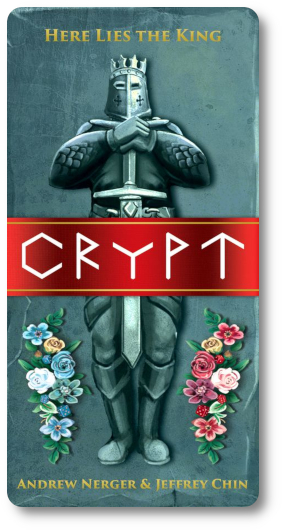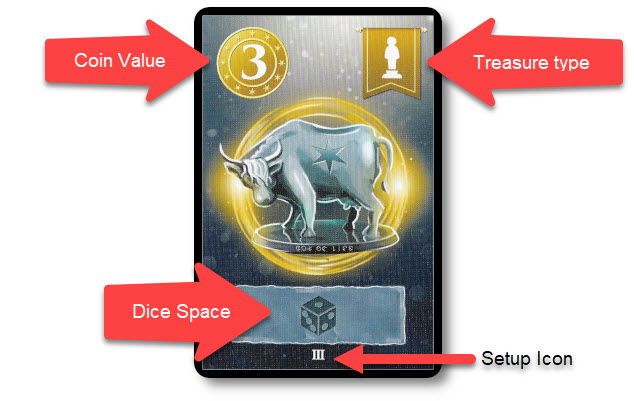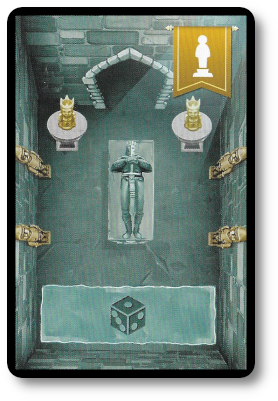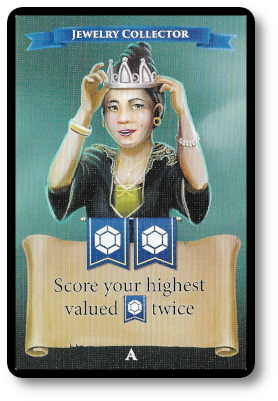
The Basics:
- For ages 8 and up (publisher suggests 12+)
- For 1 to 4 players
- Approximately 30 minutes to complete
Geek Skills:
- Counting & Math
- Logical & Critical Decision Making
- Reading
- Strategy & Tactics
- Risk vs. Reward
- Hand/Resource Management
- Worker Placement & Area Control
Learning Curve:
- Child – Easy
- Adult – Easy
Theme & Narrative:
- The dead king owes you…and you plan on getting what is yours
Endorsements:
- Gamer Geek approved!
- Parent Geek approved!
- Child Geek approved!
Overview
The King is dead! Long live the King! His passing is a hurtful blow to the realm and to your wallet. The King promised you a number of his treasures, but those are now safely entombed with the remains of the fallen lord. Well, nuts to that! You will get what is rightfully yours! You hatch a plan to raid the crypt and steal back that which was stolen from you using your loyal servants. Unfortunately, your siblings have the same idea.
Crypt, designed by Jeff Chin, Andrew Nerger, and published Road To Infamy Games, is comprised of 60 cards and 12 Servant dice (standard six-sided, four sets of three dice per color). The cards are slightly thicker and a little more durable than your standard playing card. The artwork, also by Jeff Chin, is colorful and does an OK job of representing the various game mechanic and thematic elements without cluttering up the cards. Of significant note is the detail the game publisher put into the game box itself. It looks like a stone crypt. Open it up and you’ll find the now-dead king at the bottom of the box. Great stuff.
Prepping for the Crypt
To set up the game, first find and remove a specified number and type of Treasure cards from the deck. The amount and type removed is dependent on the number of players (fewer players, fewer cards). Place any removed to one side, as they will not be used during the game. Shuffle the remaining Treasure cards and place the pile face-down in the middle of the playing area. This is the Treasure draw deck for the duration of the game. Place the empty bottom of the game box next to the draw deck.
Second, find and place the six Collector cards in a row below the Treasure draw deck. The Collector cards have an “A” and “B” side. Either may be used. It’s suggested that the “A” side be used for all Collector cards if this is your first game or you are playing with others who are not familiar with the game.
Third, have each player select their Player card of choice or randomly deal one out to each participant. Each player should then take the three Servant dice that match the color of their Player card. Any dice not used should be placed to one side, as they will not be used during the game.
Fourth, randomly determine a player to start with the Leader card. The player to the right of the Leader is given the Lights Out card.
That’s it for game set up. Time to get what is rightfully yours!
Crypt Robbing for Fun and Profit
Crypt is played in rounds and turns with no set number of rounds per game. A game round is summarized here.
Step One: Reveal the Treasure in the Crypt
The Lead player draws a number of Treasure cards as determined by the number of players in the game. The cards drawn are placed face-up with the last one or possible last two (again, depends on the number of players) remaining face-down. These drawn Treasure cards are placed in a row and should be visible to all players. This row is referred to as the “Crypt”.
The face-up Treasure cards give the players a good deal of information. The Coin value determines not only the overall value of the treasure (values 1 through 4) but is used to determine the winner at the end of the game. The Treasure type is essential to the Collectors who are looking for specific types of treasure. The Dice space is there to hold Servant dice assigned by the player (it’s just space). The setup icon is used during game setup and has no impact on the gameplay.

In contrast, the face-down Treasure cards only reveal to the player the type of treasure.

Step Two: Claim the Treasure
Starting with the Lead player and continuing clockwise around the table, each player will take one of two possible actions.
Claim (Action)
The player places their available Servant dice found on their Player card on the Dice spaces of the Treasure cards they hope to collect at the end of the round (or maybe not…players are welcome to bluff). The player can select any number value, and two or three dice can be placed on the same Treasure card if all dice have the same number value. The number value signifies the Servant’s level of effort and dedication to claim the treasure for the player. The higher the value, the more energy is being exerted. Caution should be taken, as a Servant die could become “exhausted”.
If an opponent has placed one or more Servant dice on a Treasure card the player wants, they can “push” the other Servant dice off the Treasure card by placing any number of Servant die with a combined total number value higher than the current Servant dice that occupy the Treasure card. For example, if the Treasure card had a previously placed Servant die with the value of “3”, the player could push that Servant die off by adding their own Servant die with a value of “4” or higher, or they could place two Servant die with a value of “2”, which would have a combined value of “4” (higher than “3”). Pushed Servant dice are returned to their owning player.
The last player to claim (the one with the “Lights Out” card) is only allowed to place their Servant dice on one Treasure card. Yes, it sucks to go last in this game, but the turn order sequence changes each round, so don’t get too upset.
Recover (Action)
This action allows the player to take all their exhausted Servant dice, returning them to their Player card.
Step Three: Collect the Treasure!
First, any unclaimed (no Servant dice are on the card) Treasure cards are discarded into the game box (back with the remains of the king). No one wanted them, so we won’t worry about them. The dead guy can have them again.
Second, and starting with the Lead player, each player takes the dice on the Treasure card they occupy, announces the value of the dice on that card (the level of effort being exerted by the Servants), and rolls them. If the rolled value is less than their level of energy, that Servant die is “exhausted” and is placed next to the game box. There it will remain until the player takes the Recover action. Any Servant die with a value of “1” need not be rolled. Regardless of any Servant dice being exhausted or not, the Treasure card is also collected by the player. Claimed Treasure cards should be placed face-down and organized into columns using the Treasure type.
If the player has collected enough Treasure cards of a specific type to meet the requirements of one of the Collector cards, they may receive the noted reward during the game. Collector cards are not owned by a single player. They are available to all during the entire game. Some Collectors allow the player to activate their reward during the game. If they are, they are flipped over. In game terms, the “B” side of the Collector card is the “Action”, wherein the “A” side is bonus points at the end of the game. Collectors can only be flipped once per game.

Step Four: Pass the Torch
The round is now over. The Leader card is now passed to the player who had the “Lights Out” card (they are now the first player in the next round). The “Lights Out” card is passed to the next player to the player’s right.
The next round now begins starting with Step One noted above.
Treasure for All, Victory for One
The game comes to an end when the Treasure deck is exhausted. The round is completed as usual. Players now tally the Coin values of their collected Treasure cards. Players should make sure that they take into account any benefits provided by the Collector cards if they meet the Collector card’s requirements. Exhausted Servant die give the player one Coin, as well. Isn’t that weird? The players are, thematically speaking, being rewarded for working their servants like dogs.
The player with the greatest total Coin value wins the game!
To learn more about Crypt, visit the game’s web page.
Final Word
 The Child Geeks quickly understood the rules and dived in. They enjoyed the game’s speed and how much control they had on their turn. There is hidden information in the game, but it never tripped up the Child Geeks or slowed their turns down. According to one Child Geek, “I think it is funny we are robbing a grave, but I like that I’m not the one doing it. I’ll send out my servants to do my dirty work!” Another Child Geek said, “I think the game is a lot of fun. The rules seemed hard at first, but once you start playing the game, it is really easy to have fun.” When the last Servant returned, and the crypt of the dead king was resealed, the Child Geeks all voted to fully approve Crypt.
The Child Geeks quickly understood the rules and dived in. They enjoyed the game’s speed and how much control they had on their turn. There is hidden information in the game, but it never tripped up the Child Geeks or slowed their turns down. According to one Child Geek, “I think it is funny we are robbing a grave, but I like that I’m not the one doing it. I’ll send out my servants to do my dirty work!” Another Child Geek said, “I think the game is a lot of fun. The rules seemed hard at first, but once you start playing the game, it is really easy to have fun.” When the last Servant returned, and the crypt of the dead king was resealed, the Child Geeks all voted to fully approve Crypt.
 The Parent Geeks found the game to be an excellent time, with a great mix of casual gameplay and engaging player interaction. According to one Parent Geek, “An easy game to set up, learn, and to love. I’ve played many set collecting games in the past, and this one is right up there now in my top five. I enjoyed it.” Another Parent Geek said, “I thought the game was going to be a bit too easy, but it isn’t. The rules are simple, but the risk/reward element you have with your Servants and how your turn order will influence your choices is a great addition to the gameplay. It isn’t great to go first, and it isn’t great to go last. I had a lot of fun with my fellow grave robbers.” After all the treasure was accounted for, the Parent Geeks voted to fully approve Crypt.
The Parent Geeks found the game to be an excellent time, with a great mix of casual gameplay and engaging player interaction. According to one Parent Geek, “An easy game to set up, learn, and to love. I’ve played many set collecting games in the past, and this one is right up there now in my top five. I enjoyed it.” Another Parent Geek said, “I thought the game was going to be a bit too easy, but it isn’t. The rules are simple, but the risk/reward element you have with your Servants and how your turn order will influence your choices is a great addition to the gameplay. It isn’t great to go first, and it isn’t great to go last. I had a lot of fun with my fellow grave robbers.” After all the treasure was accounted for, the Parent Geeks voted to fully approve Crypt.
 The Gamer Geeks found Crypt to be reasonably light, but none the less enjoyable and engaging. They all believed the game was a great one as a game filler and had, even more, to say about it individually. According to one Gamer Geek, “A tight game, easy rules but the choices a player needs to make are important. This is not a game you can play if you aren’t paying attention. A good mix of hidden information, risk, and reward.” Another Gamer Geek said, “An excellent game to play with casual players or if I have some downtime between games or I’m waiting for others to arrive. This is the kind of game I always look for in my collection as a solid filler.” The Gamer Geeks all raised a glass in honor of the fallen king and fully approved of the game.
The Gamer Geeks found Crypt to be reasonably light, but none the less enjoyable and engaging. They all believed the game was a great one as a game filler and had, even more, to say about it individually. According to one Gamer Geek, “A tight game, easy rules but the choices a player needs to make are important. This is not a game you can play if you aren’t paying attention. A good mix of hidden information, risk, and reward.” Another Gamer Geek said, “An excellent game to play with casual players or if I have some downtime between games or I’m waiting for others to arrive. This is the kind of game I always look for in my collection as a solid filler.” The Gamer Geeks all raised a glass in honor of the fallen king and fully approved of the game.
 Crypt is flat-out fun. I wouldn’t think much about it if it weren’t for that little rule in the game that forces players to roll their Servant dice to determine if they are still available. This was, in my opinion, the winning stroke. Players now risk their dice when they push hard to collect Treasure cards. This forces players, in turn, to determine the “real value” of the Treasure card they hope to receive. As a result, a player’s turn is more about risk analysis and then comparing it to the reward they expect to win. No player ever became vapor-locked, unable to make a choice, but it was clear that each of our players thought about their dice placement before they completed their turn.
Crypt is flat-out fun. I wouldn’t think much about it if it weren’t for that little rule in the game that forces players to roll their Servant dice to determine if they are still available. This was, in my opinion, the winning stroke. Players now risk their dice when they push hard to collect Treasure cards. This forces players, in turn, to determine the “real value” of the Treasure card they hope to receive. As a result, a player’s turn is more about risk analysis and then comparing it to the reward they expect to win. No player ever became vapor-locked, unable to make a choice, but it was clear that each of our players thought about their dice placement before they completed their turn.
And yet, there is still an element of luck here that must be acknowledged. When you roll those dice, you are hoping that the rolled value doesn’t take your die out of commission. Statistically speaking, you are much more likely to lose a die with a higher value, but you also run the same chance of losing the Servant die of a lower value. It’s random, and luck (if you believe in such a thing) can feel a bit too heavy. This was mentioned a few times by our players, so it’s of value to mention here, as well. However, it did not once stop the game or reduce the “fun” it provided. Just keep in mind that the players are always at the mercy of random outcomes that they can somewhat control.
For those who have played many games and consider themselves “elite game players”, I have no doubt you’ll find Crypt to be a solid game but a bit on the “meh” side. It does its job but without a lot of flair. And therein lies its charm. Because of its subtle and no-frills approach, it worked for all our players. Do give this game a try when you get a chance. I think you’ll find it worth digging up and putting on your family gaming table.
This game was given to Father Geek as a review copy. Father Geek was not paid, bribed, wined, dined, or threatened in vain hopes of influencing this review. Such is the statuesque and legendary integrity of Father Geek.



